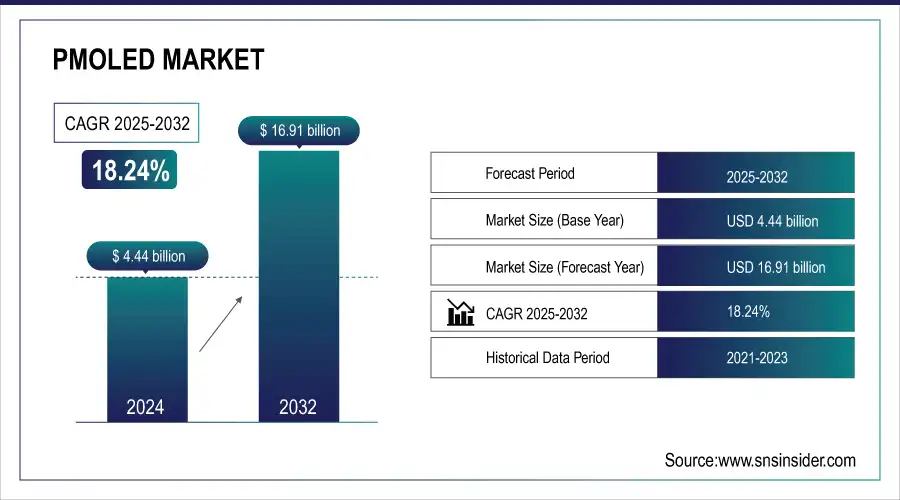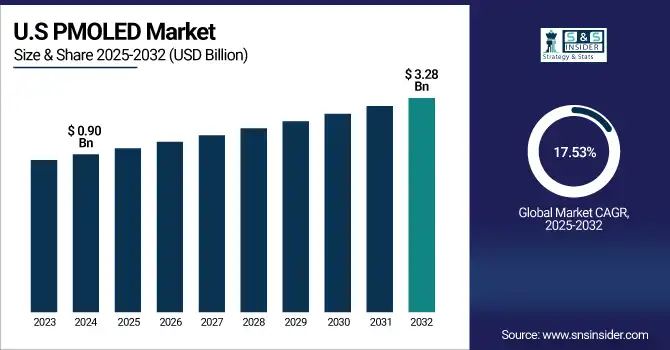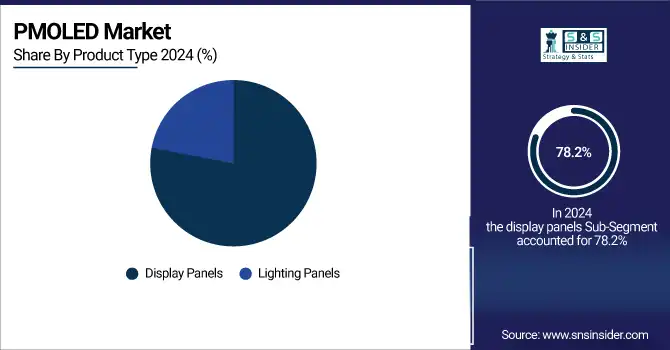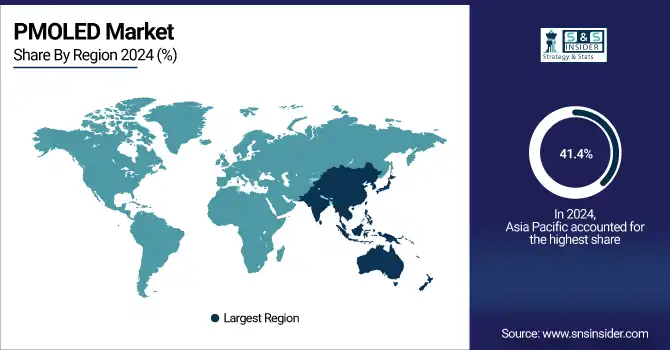PMOLED Market Size & Trends:
The PMOLED Market size was valued at USD 4.44 billion in 2024 and is expected to reach USD 16.91 billion by 2032, growing at a CAGR of 18.24% over the forecast period of 2025-2032. PMOLED market trends are growing adoption in wearables, automotive displays, industrial devices, improved resolution, flexible panels, and energy-efficient designs. PMOLED demand is on the founding, majorly arising from the increasing demand for compact, lightweight, and energy-efficient displays in consumer electronics, wearables, and automotive applications. Growth is further being propelled by rising adoption in industrial equipment and medical devices and continued improvements to display resolution, color, quality, and flexible form factors. Broad adoption is underpinned by the large volume of smart devices and IoT applications, and low-cost development requirements. Moreover, rising investments in inclined display technology and fast-paced innovations in display technologies by leading manufacturers are further driving the growth of the market.

To Get more information On PMOLED Market - Request Free Sample Report
Hyundai Mobis launched the world’s first rollable automotive display in April 2023, featuring up to ~30-inch QHD screens that retract when not in use highlighting advanced PMOLED integration in modern vehicle interiors.
The U.S. PMOLED market size was valued at USD 0.90 billion in 2024 and is expected to reach USD 3.28 billion by 2032, growing at a CAGR of 17.53% over the forecast period of 2025-2032. Driven by increasing adoption of U.S. PMOLED in wearable devices, automotive displays, and medical devices, combined with consumer inclination toward high-efficiency, small-size, and high-resolution display due to rapid progression of U.S. versatile display technology & electronics innovations, U.S. PMOLED market will grow significantly over the forecast period.

PMOLED Market Dynamics:
Drivers:
-
Rising Demand for Lightweight Compact Power Efficient PMOLED Displays Fuels Growth Across Multiple Industries
The global PMOLED market growth is primarily driven by rising demand for lightweight, compact, and power-efficient displays for consumer electronics, automotive, and wearables applications. Adoption is increasing in industries with advancements in display resolution, color reproduction, and the introduction of flexible form factors. The rapid integration in industrial apparatus and hospital devices will continue to encourage progress by a broad proliferation of inexpensive Internet of Things-associated devices and improving access to affordable fabrication technology.
Qingyue showcased a 20.6-inch transparent segmented PMOLED display at Display Week 2023, illustrating PMOLED’s scalability into larger commercial applications
Restraints:
-
Technological Limitations Challenge PMOLED Adoption Due to Lifespan Resolution and Refresh Rate Constraints
Due to this technological limitation, the PMOLED market being restricted right now, it have a shorter lifetime than the AMOLED and like LCD display because faster degradation of organic materials. This limit their usage for high brightness or long-time applications e. g. smart phones or outdoor displays. Additionally, PMOLED displays offer relatively low-resolution support and also slow refresh rates, which limits their use in high-definition or dynamic image applications.
Opportunities:
-
Next Generation Bendable Transparent PMOLED Panels Unlock Innovative Designs Across Automotive AR VR Smart Home
Next generation bendable and transparent PMOLED panels present new automotive interior, AR/VR headset, and smart home device design opportunities. There are growing use-cases in medical monitoring, digital signage, and specialty Industrial use-cases which will surely be high-value markets. Meanwhile, display makers are also looking to boost technology development capabilities and market expansion through higher R&D spends and strategic alliances.
Ceres Holographics partnered with Appotronics to develop transparent HUD solutions for car windshields, enabling bright, non-distractive in-car displays
Challenges:
-
Rising Competition and Production Challenges Impact the Growth and Scalability of PMOLED Technology
Additionally, competition is growing from other display technologies such as AMOLED, MicroLED, and high-end LCDs that perform better in some specs. Long lead times exist for this specialty organic materials dependent on certain supply chains and necessary mass production infrastructures are few and difficult to scale. In addition, transferring to larger sizes in other sectors comes at the burden of flexible and transparent PMOLED panels, which opens up challenges with compatibility and durability.
PMOLED Market Segmentation Analysis:
By Product Type
In 2024, display panels led the PMOLED market with a high PMOLED market share of 78.2%, considering their high adoption in consumer electronic devices, automotive displays, wearable devices, and industrial equipment. The thin form factor, bright colors of OLED panels, and flexibility help them in designing innovative products. Growing proliferation of compact and power-efficient displays in smartwatches, AR/VR devices, and portable gadgets, among others, has bolstered their dominance by far on a global scale.
During 2025 and 2032, lighting panels are expected to exhibit highest CAGR driven by growing energy-efficient OLED lighting technologies. In automotive ambient lighting, architectural illumination and specialty interiors, these panels are used more frequently. They are light in weight, flexible, glare-free, and thus present themselves with an attractive solution when it comes to conventional lighting technologies.

By Application
The largest PMOLED market share in 2024 was in consumer electronics, which drove the PMOLED market share at 58.7% in 2024, with high consumer adoption in smartphones, wearable devices, gaming consoles, and home entertainment systems. In high-end devices, the requisite for thin, lightweight, and energy-efficient displays with high color saturation has driven PMOLED incorporation. Moreover, the development of flexible and transparent display technologies is giving additional boost to this segment as it allows innovative designs in consumer devices.
Automotive displays, is forecasted to have the highest CAGR during 2025 and 2032, due to the increasing adoption of advanced infotainment, digital instrument clusters, and heads-up displays in vehicles. The trend toward electrification and autonomous operation is increasing the demand for high-contrast, high-volume freely programmable displays, which in turn is making PMOLED technology more appealing for use in automotive interiors.
By Display Size
In 2024, PMOLED displays with a diagonal of 1–3 inches represented the largest market share of 47.4%, which is due to high utilization of this display type in wearables, portable medical devices, and small consumer electronics. They are perfect for devices that require compact functionalism without compromising on visual outputs, as they have low weight, low power usage, and yet provide crisp clear displays in small packages. This is further reinforced by increasing demand for fitness trackers, smartwatches, and smaller IoT devices.
By End-Use Industry
The PMOLED market was dominated by consumer electronics, which accounted for 61.7% in 2024, as it gained rapid adoption in smartwatches, fitness trackers, digital cameras and portable gaming consoles. Being a lightweight, power-efficient display technology offering high contrast and vibrant colors, the rise in this segment is driven by consumer preference for low form-factor devices without any compromise on display performance. This pushes PMOLED deeper into the next-gen consumer space, with expanded IoT integration.
PMOLED Market Regional Outlook:
The Asia Pacific region led the global PMOLED market and accounted for 41.4% of market share in 2024, and is projected to exhibit the highest CAGR during the forecast period. The strong electronics manufacturing capacity enabled by countries such as China, Japan, and South Korea coupled with growing penetration of PMOLED displays in consumer electronics, automotive, and industrial applications are the factors attributing to regional leadership. The market is likely to gain traction in the upcoming years due to rising investments in premium display technologies and increasing penetration of IoT-enabled devices.

Get Customized Report as per Your Business Requirement - Enquiry Now
As the home of a well-developed electronics manufacturing base, high demand of consumer electronics and also massive investment in developing advanced display technologies and production capacity, China occupied, by far, the largest portion of Asia Pacific PMOLED market in 2024.
North America represented a leading position in the PMOLED market in 2024, due to technological advancements, the growing consumer electronics and the rising automotive displays, luxury and low-end markets. Abundant research and development infrastructure which is a positive factor for display technologies innovation in the country. Increase in wearable devices, production display, and therapeutic equipment is expected to lift the market. This, coupled with investments in next-generation display solutions and early adopters of advanced technology, has made the region a significant consideration for a larger global market expansion.
Europe is a significant market for PMOLED, particularly within the automotive displays, consumer electronics, and industrial applications. The presence of a strong manufacturing base in the region along with strong research and development capabilities is aiding the ceaseless advancements in display technology. Increased use in smart gadgets and healthcare devices is one of the additional aspects fuelling growth. Owing to favorable regulatory frameworks and demand for energy efficiency and flexible displays, Europe is a promising destination for the development and integration of the technology in the global PMOLED market.
PMOLED technology is experiencing an uptick driven by increasing penetration into consumer electronic, automotive display, and digital signage applications in Latin America, and MEA, which are growing markets. Urbanization, growing retail industries, and higher disposable incomes are driving demand. Although market penetration is still not as widespread as in developed regions, enhancements to technological infrastructure and investments in smart solutions offer considerable growth potential in the years ahead across these regions.
PMOLED Companies are:
The Key Players in PMOLED Market are Universal Display Corporation, RiTdisplay Corporation, WiseChip Semiconductor Inc., Visionox Technology Inc., Japan Display Inc., Raystar Optronics Inc., Seiko Instruments Inc., New Vision Display, Pervasive Displays Inc., Kyocera Display Corporation, InnoLux Corporation, Emerging Display Technologies Corp., Toppan Printing Co., Ltd., Truly Semiconductors Limited, Shenzhen Mikan Electronics Co., Ltd., Densitron Technologies Ltd., Microtips Technology Inc., AZ Displays Inc., Luminex Corporation, and 4D Systems Pty Ltd.
Recent Developments:
-
In July 2024, RiTdisplay teamed up with VueReal to leverage its advanced backplane process and VueReal’s MicroSolid Printing™ technology, targeting scalable, high-performance, transparent microLED displays for consumer and AR markets.
| Report Attributes | Details |
|---|---|
| Market Size in 2024 | USD 4.44 Billion |
| Market Size by 2032 | USD 16.91 Billion |
| CAGR | CAGR of 18.24% From 2025 to 2032 |
| Base Year | 2024 |
| Forecast Period | 2025-2032 |
| Historical Data | 2021-2023 |
| Report Scope & Coverage | Market Size, Segments Analysis, Competitive Landscape, Regional Analysis, DROC & SWOT Analysis, Forecast Outlook |
| Key Segments | • By Product Type (Display Panels, and Lighting Panels) • By Application (Consumer Electronics, Automotive Displays, Industrial Equipment Displays, and Healthcare Devices) • By Display Size (Up to 1 inch, 1–3 inches, 3–6 inches, and Above 6 inches) • By End-Use Industry (Consumer Electronics, Automotive, Industrial, and Healthcare) |
| Regional Analysis/Coverage | North America (US, Canada, Mexico), Europe (Germany, France, UK, Italy, Spain, Poland, Turkey, Rest of Europe), Asia Pacific (China, India, Japan, South Korea, Singapore, Australia, Taiwan, Rest of Asia Pacific), Middle East & Africa (UAE, Saudi Arabia, Qatar, South Africa, Rest of Middle East & Africa), Latin America (Brazil, Argentina, Rest of Latin America) |
| Company Profiles | Universal Display Corporation, RiTdisplay Corporation, WiseChip Semiconductor Inc., Visionox Technology Inc., Japan Display Inc., Raystar Optronics Inc., Seiko Instruments Inc., New Vision Display, Pervasive Displays Inc., Kyocera Display Corporation, InnoLux Corporation, Emerging Display Technologies Corp., Toppan Printing Co., Ltd., Truly Semiconductors Limited, Shenzhen Mikan Electronics Co., Ltd., Densitron Technologies Ltd., Microtips Technology Inc., AZ Displays Inc., Luminex Corporation, 4D Systems Pty Ltd. |

